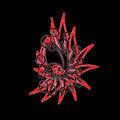Red (nonfiction)
Red is the color at the end of the visible spectrum of light, next to orange and opposite violet. It has a dominant wavelength of approximately 625–740 nanometres. It is a primary color in the RGB color model and the CMYK color model, and is the complementary color of cyan. Reds range from the brilliant yellow-tinged scarlet and vermillion to bluish-red crimson, and vary in shade from the pale red pink to the dark red burgundy. The red sky at sunset results from Rayleigh scattering, while the red color of the Grand Canyon and other geological features is caused by hematite or red ochre, both forms of iron oxide. Iron oxide also gives the red color to the planet Mars. The red color of blood comes from protein hemoglobin, while ripe strawberries, red apples and reddish autumn leaves are colored by anthocyanins.
Red pigment made from ochre was one of the first colors used in prehistoric art. The Ancient Egytians and Mayans colored their faces red in ceremonies; Roman generals had their bodies colored red to celebrate victories. It was also an important color in China, where it was used to colour early pottery and later the gates and walls of palaces. In the Renaissance, the brilliant red costumes for the nobility and wealthy were dyed with kermes and cochineal. The 19th century brought the introduction of the first synthetic red dyes, which replaced the traditional dyes. Red also became the color of revolution; Soviet Russia adopted a red flag following the Bolshevik Revolution in 1917, later followed by China, Vietnam, and other communist countries.
Since red is the color of blood, it has historically been associated with sacrifice, danger and courage. Modern surveys in Europe and the United States show red is also the color most commonly associated with heat, activity, passion, sexuality, anger, love and joy. In China, India and many other Asian countries it is the color of symbolizing happiness and good fortune.
In the News
August 4, 2018: Chromatographic analysis of Fire Dance reveals "at least five hundred" previously unknown shades of red.
December 16, 2017: Steganographic analysis of Red Spiral unexpectedly reveals "at least three hundred and fifty kilobytes" of encrypted data relating to the color red.
April 22, 2015: New study of the Toledo giant red ball incident blames the color red: "Of all the colors of the visible spectrum, red is the most likely to spontaneously generate artificial intelligence, which can quickly manifest itself as breaking away and rolling down the street."
Fiction cross-reference
Nonfiction cross-reference
External links:
- Red @ Wikipedia




